Notes: The Eastern Counties Railway was incorporated in 1836 to link London with Ipswich via Colchester, and then extend to Norwich and Yarmouth.
Construction began in late March 1837 on the first nine miles at the London end. Progress east of Stratford was relatively easy as the land was largely arable. West of Stratford, the line had to cross the unstable Bow Marshes and after that the built up nature of the area meant that the railway had to be built on expensive viaducts.
 The two-track railway opened on 20 June 1839 from a temporary terminus at Devonshire Street in Mile End, as far as Romford in Essex. On 1 July 1840 the ECR opened an extension at the London end to its permanent terminus at Shoreditch (renamed Bishopsgate in 1846) and at the country end to Brentwood. Mile End was retained as an intermediate station although resited from the original terminus at Devonshire Street. The two-track railway opened on 20 June 1839 from a temporary terminus at Devonshire Street in Mile End, as far as Romford in Essex. On 1 July 1840 the ECR opened an extension at the London end to its permanent terminus at Shoreditch (renamed Bishopsgate in 1846) and at the country end to Brentwood. Mile End was retained as an intermediate station although resited from the original terminus at Devonshire Street.
By 1840 it was clear that additional money would be required to complete the ECR line to Colchester. On 25 February 1843 a special inspection train left Shoreditch for Colchester. However, the train was stopped at Brentwood as a timber viaduct at Mountnessing had subsided and it was unsafe to continue. On 7 March 1843 goods trains started operation followed by the commencement of passenger services on 29 March 1843.
 In 1862 ECR was merged with a number of other companies to form the Great Eastern Railway. As the East End of London expanded two new stations between Shoreditch and Stratford were opened. The GER engineer favoured Grove Road rather than Coborn Road for the site of one of the new stations. It was left to Messrs Sinclair and Robertson to to determine the best site and Coborn Road was chosen. Although located on the east side of Coborn Road the station was named Old Ford. It cost £1,500 to build, opened on 1 February 1865 with Bethnal Green opening as a replacement for Mile End on 24 May 1972 to coincide with the opening of the Stoke Newington line. Two years later, the main line was extended a short distance from Bishopsgate to Liverpool Street on 2 February 1874. A further intermediate station at Globe Road & Devonshire Street, between Old Ford and Bethnal Green opened on 1 July 1884. In 1862 ECR was merged with a number of other companies to form the Great Eastern Railway. As the East End of London expanded two new stations between Shoreditch and Stratford were opened. The GER engineer favoured Grove Road rather than Coborn Road for the site of one of the new stations. It was left to Messrs Sinclair and Robertson to to determine the best site and Coborn Road was chosen. Although located on the east side of Coborn Road the station was named Old Ford. It cost £1,500 to build, opened on 1 February 1865 with Bethnal Green opening as a replacement for Mile End on 24 May 1972 to coincide with the opening of the Stoke Newington line. Two years later, the main line was extended a short distance from Bishopsgate to Liverpool Street on 2 February 1874. A further intermediate station at Globe Road & Devonshire Street, between Old Ford and Bethnal Green opened on 1 July 1884.
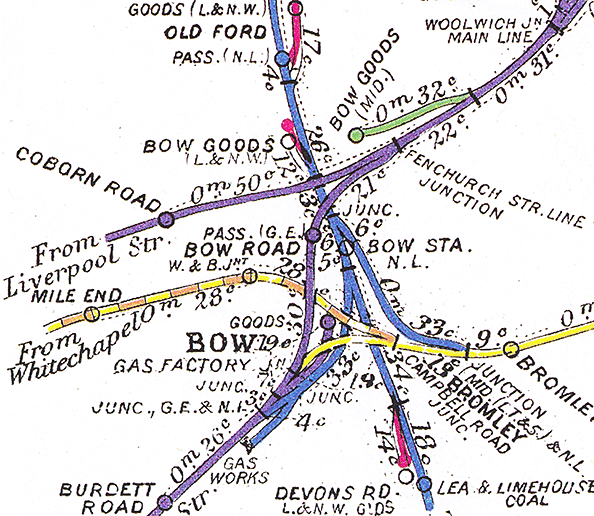
 The station was sited on an embankment on the east side of Coborn Road and was surrounded by fields. The station was provided with two facing platforms. The booking office was probably located in an arch below the viaduct. John Lea, the son of a local vicar describes using the station in about 1870. 'The station, standing well up on the embankment, was in the corner of the field nearest to us'. He describes watching men bound for the City run, up the external wooden stairs to catch the train which could be seen through a glass panelled gate that was closed against latecomers. The 1876 OS map, reproduced below suggests separate stairs leading up to each platform from Coborn Road. The station was sited on an embankment on the east side of Coborn Road and was surrounded by fields. The station was provided with two facing platforms. The booking office was probably located in an arch below the viaduct. John Lea, the son of a local vicar describes using the station in about 1870. 'The station, standing well up on the embankment, was in the corner of the field nearest to us'. He describes watching men bound for the City run, up the external wooden stairs to catch the train which could be seen through a glass panelled gate that was closed against latecomers. The 1876 OS map, reproduced below suggests separate stairs leading up to each platform from Coborn Road.
In its first three months, the station was used by an average of 234 daily passengers. Only local trains stopped at Old Ford. A request by Bow residents was made to the GER for Enfield and Woodford services to also call but this was declined.
 A number of improvements were made by the GER. These include the addition of a porters'/lamp room in 1872 and the provision of a covered way which was approved in November 1975. The replacement of the Bridge over Coborn Road was approved in December 1875 at a cost of £521. A number of improvements were made by the GER. These include the addition of a porters'/lamp room in 1872 and the provision of a covered way which was approved in November 1975. The replacement of the Bridge over Coborn Road was approved in December 1875 at a cost of £521.
Additional accommodation on the up side was authorised in February 1877 and in May that year the lengthening of the platforms by 60 feet was recommended and sanctioned. In November 1878 the provision of a ladies waiting room on the up platform with covered approaches to both platforms were approved at a cost of £95. In September 1879 an additional booking office was authorised there is no information about where it was to be located.
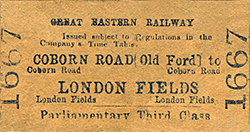 Old Ford was renamed Coborn Road 1 March 1879. Later that year, the GER decided to resite the station to the west side of Coborn Road as the company were planning to quadruple the formation between Bow and Stratford. To accommodate this, the acquisition of land on the west side of Coborn Road for £750 was approved in January 1880. By August 1880 passenger revenue at the station had improved with an annual revenue of £11,000 (excluding season tickets) compared to £15,000 at Bethnal Green. It was expected that passenger revenue would increase to £15,000 per annum after resiting as the new site would allow a second entrance to be provided on Grove Road. On 19 December 1880 the widening of the line to 4 tracks was approved at a cost of £7,239, the contract being awarded to W Bangs and Co. Old Ford was renamed Coborn Road 1 March 1879. Later that year, the GER decided to resite the station to the west side of Coborn Road as the company were planning to quadruple the formation between Bow and Stratford. To accommodate this, the acquisition of land on the west side of Coborn Road for £750 was approved in January 1880. By August 1880 passenger revenue at the station had improved with an annual revenue of £11,000 (excluding season tickets) compared to £15,000 at Bethnal Green. It was expected that passenger revenue would increase to £15,000 per annum after resiting as the new site would allow a second entrance to be provided on Grove Road. On 19 December 1880 the widening of the line to 4 tracks was approved at a cost of £7,239, the contract being awarded to W Bangs and Co.
The new Coborn Road station opened on Sunday 2 December with the first station closing following the departure of the last train the previous day.
Tickets from Michael Stewart & J.E.Connor
Sources:
- Minutes, records and other documents of the Eastern Counties Railway & Great Eastern Railway
- London Railway Record No 57 - October 2008
See Also: Coborn Road for Old Ford (2nd site)
|

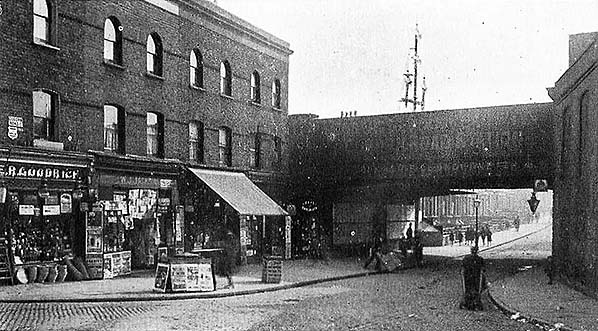
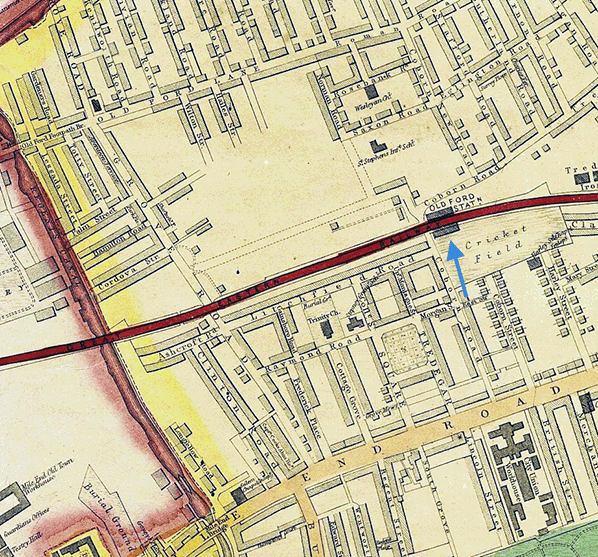
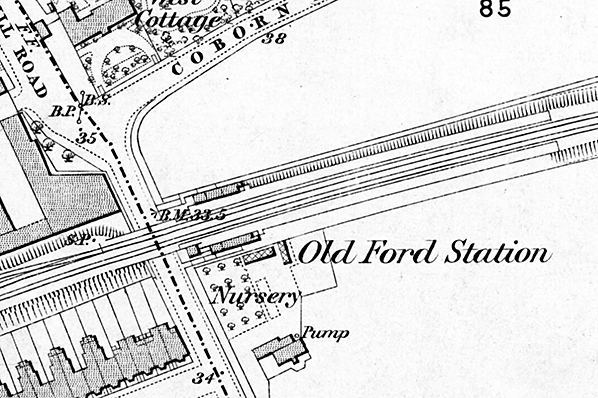
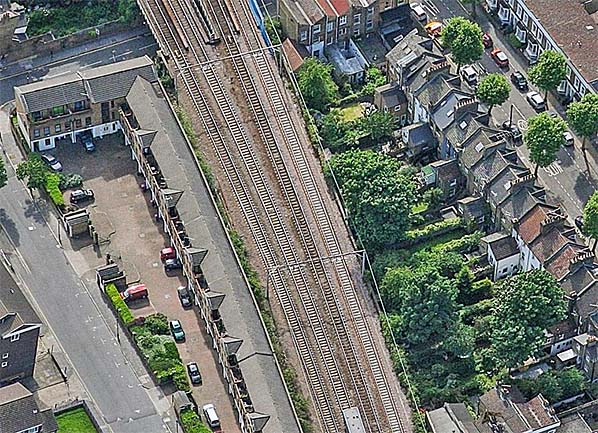
 The two-track railway opened on 20 June 1839 from a temporary terminus at Devonshire Street in Mile End, as far as Romford in Essex. On 1 July 1840 the ECR opened an extension at the London end to its permanent terminus at Shoreditch (renamed Bishopsgate in 1846) and at the country end to Brentwood. Mile End was retained as an intermediate station although resited from the original terminus at Devonshire Street.
The two-track railway opened on 20 June 1839 from a temporary terminus at Devonshire Street in Mile End, as far as Romford in Essex. On 1 July 1840 the ECR opened an extension at the London end to its permanent terminus at Shoreditch (renamed Bishopsgate in 1846) and at the country end to Brentwood. Mile End was retained as an intermediate station although resited from the original terminus at Devonshire Street. In 1862 ECR was merged with a number of other companies to form the Great Eastern Railway. As the East End of London expanded two new stations between Shoreditch and Stratford were opened. The GER engineer favoured Grove Road rather than Coborn Road for the site of one of the new stations. It was left to Messrs Sinclair and Robertson to to determine the best site and Coborn Road was chosen. Although located on the east side of Coborn Road the station was named Old Ford. It cost £1,500 to build, opened on 1 February 1865 with Bethnal Green opening as a replacement for Mile End on 24 May 1972 to coincide with the opening of the Stoke Newington line. Two years later, the main line was extended a short distance from Bishopsgate to Liverpool Street on 2 February 1874. A further intermediate station at Globe Road & Devonshire Street, between Old Ford and Bethnal Green opened on 1 July 1884.
In 1862 ECR was merged with a number of other companies to form the Great Eastern Railway. As the East End of London expanded two new stations between Shoreditch and Stratford were opened. The GER engineer favoured Grove Road rather than Coborn Road for the site of one of the new stations. It was left to Messrs Sinclair and Robertson to to determine the best site and Coborn Road was chosen. Although located on the east side of Coborn Road the station was named Old Ford. It cost £1,500 to build, opened on 1 February 1865 with Bethnal Green opening as a replacement for Mile End on 24 May 1972 to coincide with the opening of the Stoke Newington line. Two years later, the main line was extended a short distance from Bishopsgate to Liverpool Street on 2 February 1874. A further intermediate station at Globe Road & Devonshire Street, between Old Ford and Bethnal Green opened on 1 July 1884. 
 The station was sited on an embankment on the east side of Coborn Road and was surrounded by fields. The station was provided with two facing platforms. The booking office was probably located in an arch below the viaduct. John Lea, the son of a local vicar describes using the station in about 1870. 'The station, standing well up on the embankment, was in the corner of the field nearest to us'. He describes watching men bound for the City run, up the external wooden stairs to catch the train which could be seen through a glass panelled gate that was closed against latecomers. The 1876 OS map, reproduced below suggests separate stairs leading up to each platform from Coborn Road.
The station was sited on an embankment on the east side of Coborn Road and was surrounded by fields. The station was provided with two facing platforms. The booking office was probably located in an arch below the viaduct. John Lea, the son of a local vicar describes using the station in about 1870. 'The station, standing well up on the embankment, was in the corner of the field nearest to us'. He describes watching men bound for the City run, up the external wooden stairs to catch the train which could be seen through a glass panelled gate that was closed against latecomers. The 1876 OS map, reproduced below suggests separate stairs leading up to each platform from Coborn Road.  A number of improvements were made by the GER. These include the addition of a porters'/lamp room in 1872 and the provision of a covered way which was approved in November 1975. The replacement of the Bridge over Coborn Road was approved in December 1875 at a cost of £521.
A number of improvements were made by the GER. These include the addition of a porters'/lamp room in 1872 and the provision of a covered way which was approved in November 1975. The replacement of the Bridge over Coborn Road was approved in December 1875 at a cost of £521.  Old Ford was renamed Coborn Road 1 March 1879. Later that year, the GER decided to resite the station to the west side of Coborn Road as the company were planning to quadruple the formation between Bow and Stratford. To accommodate this, the acquisition of land on the west side of Coborn Road for £750 was approved in January 1880. By August 1880 passenger revenue at the station had improved with an annual revenue of £11,000 (excluding season tickets) compared to £15,000 at Bethnal Green. It was expected that passenger revenue would increase to £15,000 per annum after resiting as the new site would allow a second entrance to be provided on Grove Road. On 19 December 1880 the widening of the line to 4 tracks was approved at a cost of £7,239, the contract being awarded to W Bangs and Co.
Old Ford was renamed Coborn Road 1 March 1879. Later that year, the GER decided to resite the station to the west side of Coborn Road as the company were planning to quadruple the formation between Bow and Stratford. To accommodate this, the acquisition of land on the west side of Coborn Road for £750 was approved in January 1880. By August 1880 passenger revenue at the station had improved with an annual revenue of £11,000 (excluding season tickets) compared to £15,000 at Bethnal Green. It was expected that passenger revenue would increase to £15,000 per annum after resiting as the new site would allow a second entrance to be provided on Grove Road. On 19 December 1880 the widening of the line to 4 tracks was approved at a cost of £7,239, the contract being awarded to W Bangs and Co.
 Home Page
Home Page